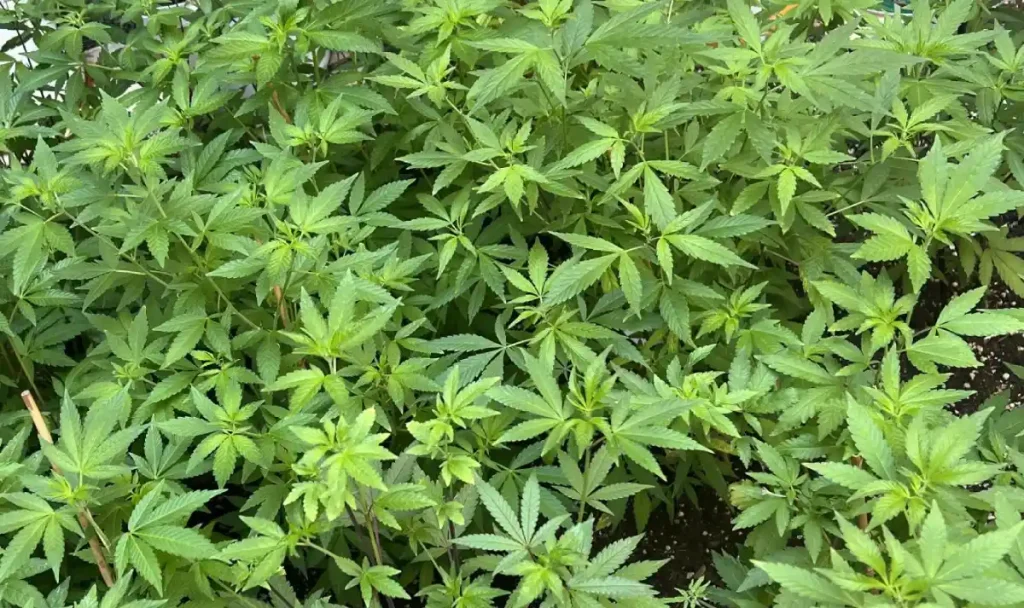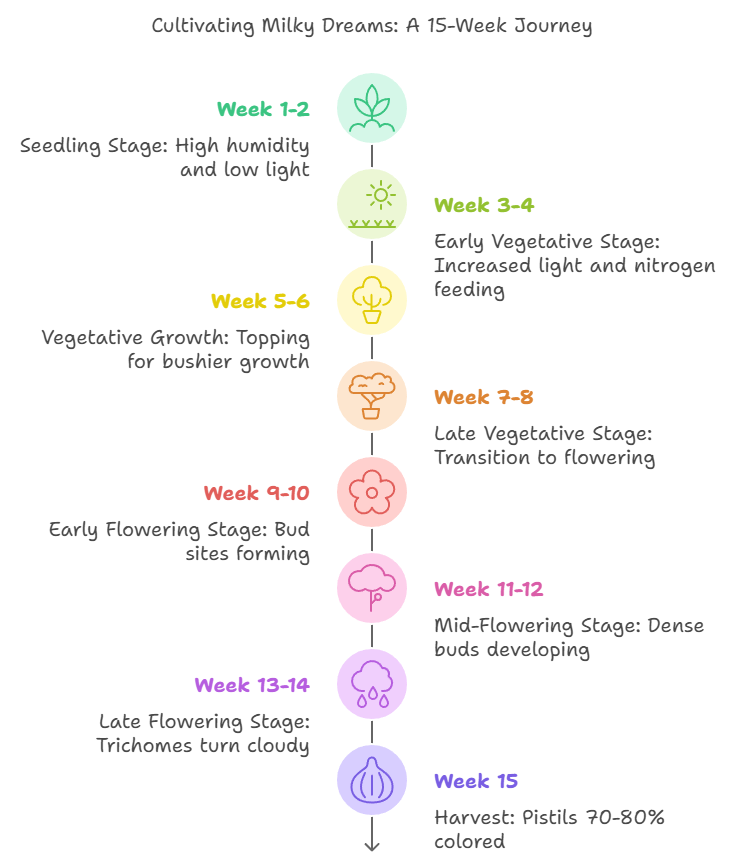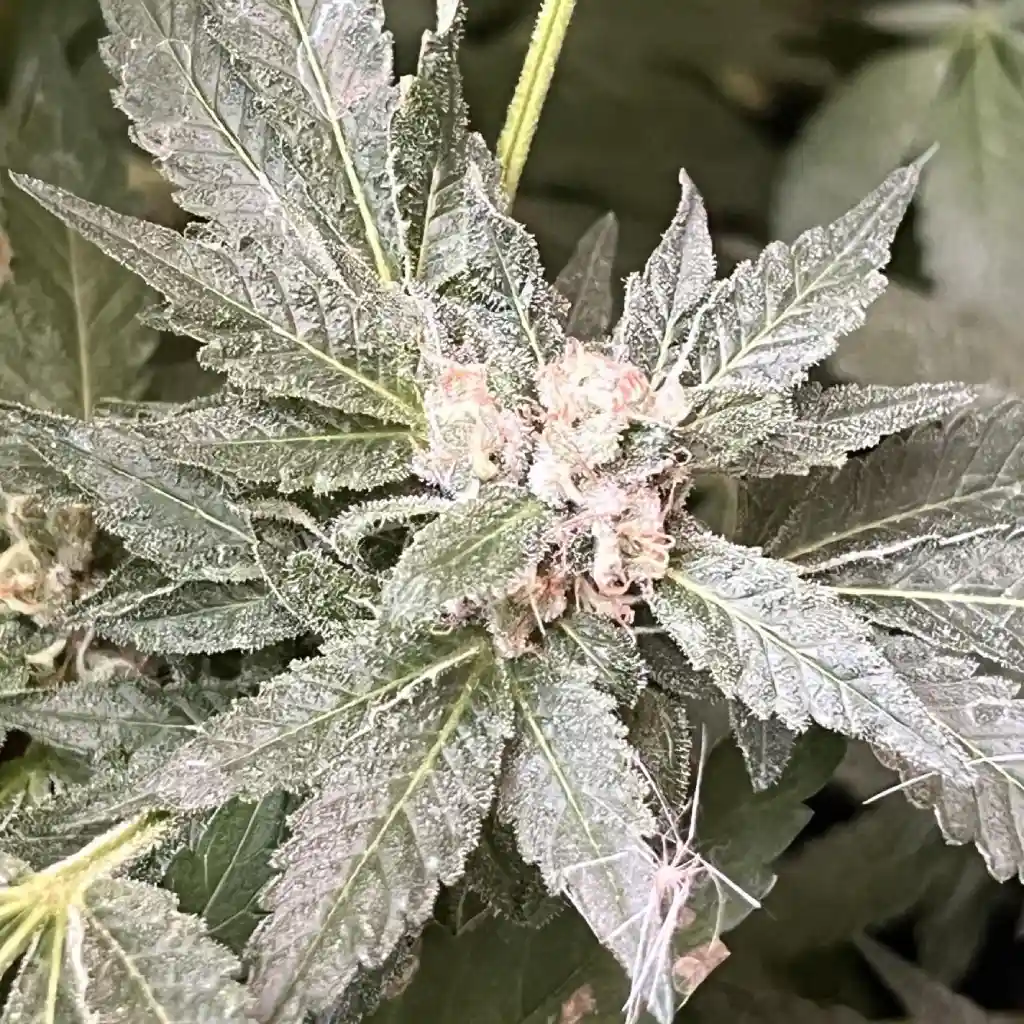Milky Dreams Strain: The Perfect Blend of Flavor and Effects
The Milky Dreams Strain is a hybrid that stands out for its rich, creamy flavor and deeply relaxing effects. Its sweet, milky aroma carries subtle hints of vanilla and fruit, creating an enticing sensory experience. Loved by both novice and experienced cannabis enthusiasts, this strain delivers a calming body high with just the right amount of mental clarity, making it ideal for evening relaxation or creative pursuits. Its versatility and appeal ensure it’s a staple in any connoisseur’s collection.
Growers appreciate the Milky Dreams Strain for its resilient growth and rewarding harvest. This strain adapts well to various cultivation setups, thriving both indoors and outdoors. Its high resin production and dense buds make it an excellent choice for crafting concentrates or enjoying as flower. Whether for medicinal or recreational use, the Milky Dreams Strain consistently delivers quality.
Environmental Requirements for Growing Milky Dreams Strain
The Milky Dreams Strain flourishes in stable environments with controlled temperature and humidity. During the vegetative phase, maintain temperatures between 70-82°F (21-28°C) and a relative humidity of 50-60%. As the plant transitions to flowering, reduce humidity to around 40-50% to enhance trichome production and prevent mold.
Good air circulation is essential to avoid pests and diseases. Whether grown indoors or outdoors, providing consistent care and monitoring environmental factors ensures this strain’s optimal health. Its robust nature allows it to adapt to minor fluctuations, but attention to detail yields the best results.
Indoor Cultivation Tips for Milky Dreams Strain
For indoor growers, the Milky Dreams Strain requires a carefully managed setup to maximize yields. Use high-quality LED lights to simulate sunlight and create an environment conducive to vigorous growth. Reflective materials in the grow space can enhance light efficiency, promoting uniform bud development.
Techniques like topping or low-stress training (LST) help manage plant height and ensure even light penetration. Maintain a steady airflow using fans and exhaust systems to regulate temperature and prevent heat buildup. With proper care, indoor cultivation of this strain produces compact, resinous buds.
Outdoor Cultivation Tips for Milky Dreams Strain
Outdoors, the Milky Dreams Strain thrives in sunny climates with consistent temperatures. Plant in nutrient-rich, well-draining soil and ensure a stable pH of 6.0-6.5 for optimal nutrient absorption. Stake plants early to support their structure and protect them from wind damage.
Monitor weather conditions to shield plants from heavy rains that could cause mold. Regularly check for pests and apply organic pest control as needed. With proper care, outdoor-grown Milky Dreams Strain produces robust plants with dense, flavorful buds that reflect its unique profile.

Harvesting and Curing for Cannabis Growing
The Milky Dreams Strain reaches its peak harvest potential when 70-80% of the pistils shift to an amber hue and trichomes turn milky with slight amber accents. This timing ensures the buds deliver maximum potency and flavor. After harvesting, hang the plants upside down in a dark, ventilated space with a steady humidity of 50% and temperatures between 60-70°F. This slow drying process is key to preserving terpenes and cannabinoids.
Once the buds are dried, begin curing them in airtight jars. Open the jars daily for the first week to release excess moisture and prevent mold. Over the next few weeks, this curing process deepens the flavor profile, enhances aroma, and ensures a smooth smoking experience, making the most of the strain’s creamy, fruity characteristics.
Is Milky Dreams Indica or Sativa?
The Milky Dreams Strain is a balanced hybrid leaning slightly towards Indica. This unique blend offers the relaxing physical effects associated with Indica while maintaining a gentle cerebral uplift typical of Sativa. The result is a versatile strain suitable for unwinding after a long day or sparking creativity without overwhelming sedation.
Advantages of Growing Milky Dreams Strain
Growing the Milky Dreams Strain comes with a host of benefits. Its compact structure is perfect for small grow spaces, making it ideal for home growers. High resin production makes this strain a favorite for concentrate enthusiasts. Its pest resistance and adaptability to various cultivation techniques simplify maintenance, even for beginners.
This strain also boasts high THC levels of 20-24%, delivering potent effects. The creamy, fruity flavor profile, paired with its balanced effects, ensures widespread appeal. Whether for personal consumption or commercial purposes, Milky Dreams offers reliable yields and top-tier quality.
Disadvantages of Growing Milky Dreams Strain
Despite its many advantages, the Milky Dreams Strain presents some challenges. Its dense buds are prone to mold if humidity levels aren’t carefully monitored, especially during the flowering stage. Growers must maintain strict humidity control and ensure adequate airflow to prevent moisture-related issues.
Additionally, this strain’s sensitivity to nutrients requires precise feeding schedules. Overfeeding can lead to nutrient burn, affecting both yield and plant health. Proper monitoring of pH levels and nutrient concentrations is essential to avoid these problems and ensure a thriving crop.
Problems in Cultivating Milky Dreams Strain
The most common issue growers face with Milky Dreams is mold, particularly in its dense, resinous buds. Keeping humidity below 50% during flowering and ensuring proper airflow are critical to avoiding this problem. Regular defoliation can also help improve air circulation.
Nutrient sensitivity is another challenge. Overfeeding or imbalanced nutrient regimens can cause stunted growth or yellowing leaves. Regularly testing the soil’s pH and adjusting nutrient levels based on the plant’s growth stage can prevent these issues and promote healthy development.
Advanced Pest Control for Cannabis Growing
For pest management, the Milky Dreams Strain benefits from advanced, integrated pest control strategies. Introducing predatory mites, such as Phytoseiulus persimilis, helps control common pests like spider mites and aphids. These biological agents offer a natural and effective way to maintain plant health without chemicals.
Preventive sprays like neem oil can be combined with beneficial insects for a layered defense. Regular inspections for early signs of infestations are essential. A clean growing environment with well-maintained humidity levels significantly reduces the likelihood of pest problems.
Similar Strains
Fans of the Milky Dreams Strain may also enjoy these complementary strains for their creamy flavors and relaxing effects:
Wedding Cheesecake Auto
Known for its sweet, creamy profile with hints of vanilla and berries, Wedding Cheesecake Auto delivers balanced effects that relax the body while uplifting the mind. It shares a similar flavor complexity and calming qualities, making it an excellent alternative to Milky Dreams Strain. This strain is also favored for its ease of growth and high resin production, making it ideal for extractions.
Cream Auto
Cream Auto is a dessert-inspired strain featuring smooth, milky undertones and a slightly earthy finish. It provides a euphoric yet calming high, making it a perfect match for those who enjoy the soothing effects of Milky Dreams Strain. Its compact structure and resilience to pests make it a great choice for indoor growers.
Gelato Auto
This hybrid is celebrated for its creamy, fruity aroma with undertones of citrus and mint. Gelato Auto provides a euphoric and focused high, offering a unique twist on the relaxing experience provided by Milky Dreams. It’s an excellent choice for users who want a more uplifting yet equally flavorful alternative.
Week-by-Week Growth Plan for Milky Dreams Strain
Week 1-2: Seedling Stage
During germination and early seedling development, maintain humidity levels between 60-70% and temperatures around 70-75°F. Use gentle, full-spectrum lighting to encourage healthy growth while avoiding stress. Water sparingly, ensuring the soil stays damp but not overly saturated. Focus on establishing a robust root system to support future growth.
Inspect seedlings daily for any signs of stress or nutrient deficiencies. Healthy seedlings will display vibrant green leaves and steady growth, laying a strong foundation for the vegetative stage.
Week 3-4: Early Vegetative Stage
As plants enter the vegetative stage, increase light intensity to encourage foliage growth. Keep humidity between 50-60% and temperatures at 70-82°F. Begin feeding a nitrogen-rich nutrient formula to promote healthy leaf and stem development. Light training techniques, such as bending or tying branches, can be introduced to shape the canopy.
Ensure consistent airflow to strengthen stems and reduce the risk of mold or pests. Monitor plants closely, adjusting nutrients or environmental factors as needed to optimize growth.
Week 5-6: Vegetative Growth
This stage is marked by rapid growth as plants establish their full structure. Apply techniques like topping or low-stress training (LST) to enhance canopy shape and increase light penetration to lower bud sites. Maintain a steady 18/6 light schedule and continue feeding nitrogen-rich nutrients.
Regularly inspect plants for pests or nutrient deficiencies, and ensure ventilation is adequate to prevent any issues. Steady airflow promotes stronger stems and healthier foliage.
Week 7-8: Late Vegetative Stage
As the vegetative stage concludes, begin transitioning plants to a 12/12 light cycle to initiate flowering. Gradually reduce humidity to around 50% and adjust nutrient formulas to include higher levels of phosphorus and potassium while tapering off nitrogen. This shift prepares plants for the demands of flower production.
Prune lower foliage to improve airflow and direct the plant’s energy toward budding sites. Ensure plants are adequately spaced to reduce overcrowding and maximize light exposure.
Week 9-10: Early Flowering Stage
Buds start forming as plants channel their energy into flower production. Keep humidity around 45-50% to reduce the risk of mold and mildew. Adjust feeding schedules to prioritize phosphorus and potassium, essential for healthy bud development.
Inspect the plants daily for pests or signs of stress. Proper ventilation and steady airflow are critical during this stage to support the plant’s increased metabolic activity.
Week 11-12: Mid-Flowering Stage
Buds become denser, and resin production intensifies, contributing to the strain’s signature potency and flavor profile. Maintain humidity at 40-50% and temperatures between 68-75°F to ensure optimal development. Regularly check trichomes for clarity and maturation to gauge plant progress.
Use supports like stakes or trellises to hold up heavy branches. Inspect plants thoroughly for any signs of nutrient imbalances or infestations, addressing issues promptly to maintain plant health.
Week 13-14: Late Flowering Stage
As the buds near maturity, trichomes will turn cloudy with some amber, indicating peak potency. Begin flushing with pure, pH-balanced water to remove excess nutrients and enhance the final product’s flavor. Lower humidity to 35-40% and ensure proper airflow to protect the buds from mold.
Monitor plants closely, focusing on trichome and pistil development to determine the ideal harvest time. Avoid overfeeding or adding unnecessary nutrients at this stage.
Week 15: Harvest
Harvest the Milky Dreams Strain when trichomes are predominantly milky with 70-80% of pistils darkened and curled inward. Use sharp, sanitized tools to cut branches and hang them upside down in a dark, well-ventilated room. Maintain temperatures around 68°F and humidity at 50% during the drying process, which typically lasts 7-10 days.
Once dried, trim excess leaves and prepare the buds for curing to achieve their full flavor and potency.
Week 16-17: Curing
Place the dried buds in airtight glass jars, filling them about 75% to allow some airflow. Store the jars in a cool, dark place, opening them daily for the first week to release moisture. This “burping” process prevents mold and ensures an even cure.
Continue curing for at least 2-3 weeks to enhance the strain’s flavor, aroma, and potency. For the best results, extend curing up to 6 weeks, as longer curing periods refine the overall quality of the final product.

FAQs
What is the THC percentage of Milky Dreams Strain?
The Milky Dreams Strain typically contains 20-24% THC, delivering a potent, well-rounded experience that combines relaxation with mental clarity. Its high THC content makes it suitable for experienced users seeking strong effects, but its balanced profile also offers approachability for those looking for therapeutic benefits. Whether used recreationally or medicinally, this strain’s potency ensures a consistent and effective high.
How long does it take for Milky Dreams Strain to flower?
Milky Dreams Strain has a flowering period of 8-9 weeks when grown under optimal conditions. Indoor setups with controlled light schedules (typically a 12/12 cycle) and stable temperatures can help ensure consistent flowering timelines. Outdoor growers should plan for harvest in late September or early October, depending on their climate.
Can Milky Dreams Strain be grown both indoors and outdoors?
Yes, Milky Dreams Strain adapts well to both indoor and outdoor environments, making it a versatile option for growers. Indoors, it thrives in controlled setups with proper ventilation, humidity levels of 40-50% during flowering, and adequate light exposure. Outdoor cultivation requires a sunny, warm climate with consistent airflow to prevent mold and pests.

